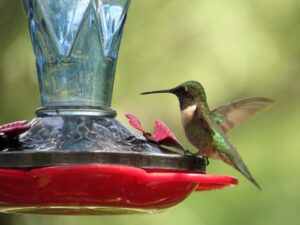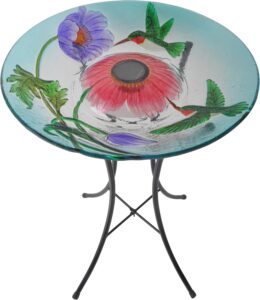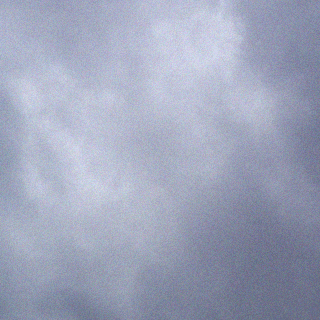If you live in an area with no natural nectar sources, you can still attract hummingbirds to your yard by creating an inviting environment tailored to their needs. Here are some key strategies:
1. Provide Nectar Feeders
-
Hang hummingbird feeders filled with a sugar-water solution made from 1 part sugar to 4 parts water. Avoid using honey, artificial
 sweeteners, or red food dye, as these can harm hummingbirds.
sweeteners, or red food dye, as these can harm hummingbirds. -
Place feeders in shaded areas to keep the nectar fresh longer and prevent spoilage.
-
Clean feeders regularly (every 2–3 days in warm weather) and replace the nectar to maintain a healthy feeding source.
-
Guide for when to change the nectar
Letting the nectar ferment encourages mold growth, which makes the cleaning process more difficult. To avoid this, follow the chart below for recommended nectar changes based on the temperature. The hotter it gets, the more frequently you’ll need to replace the nectar.
High temperatures…………Change after
71-75……………………………6 days
76-80……………………………5 days
81-84……………………………4 days
85-88……………………………3 days
89-92……………………………2 days
93+………………………………change daily
Click on the link for a detailed guide to help you clean your hummingbird feeder, especially when mold starts to grow due to nectar not being changed in time.
2. Add Bright Colors
-
Hummingbirds are naturally attracted to bright colors like red, orange, and yellow. Use brightly colored feeders or place red ribbons or decorations near the feeders to catch their attention.
3. Create a Water Source
-
While hummingbirds don’t drink water, they need it for bathing to clean sticky nectar off their feathers. Provide a shallow birdbath, fountain, or mister, ensuring it’s shallow enough for their small size.
-
Install shallow bird bathswith gently sloping edges. Hummingbirds prefer water sources that are no more than 1-1.5 inches deep.

4. Plant Native Flowers in Containers
-
If you lack natural nectar sources, grow native flowering plants in pots or hanging baskets.
-
Position your containers in sunny spots since most nectar-rich flowers thrive in full sun.
-
Incorporate red elements in your garden design to catch hummingbirds’ attention.
- lant Native Flowers in Containers to Attract Hummingbirds
Hummingbirds are dazzling, energetic pollinators that can transform your garden into a vibrant, living spectacle. While many gardeners focus on traditional flowerbeds, planting native flowers in containers is an excellent way to attract these “flying jewels,” even in small spaces like patios or balconies. Here’s a guide to creating a hummingbird-friendly container garden using native plants.
Why Choose Native Plants?
Native plants are perfectly adapted to local climates and ecosystems, providing the nectar-rich flowers hummingbirds naturally seek. They often require less maintenance and are more resilient to pests and diseases. Additionally, native plants support biodiversity by benefiting other pollinators like bees and butterflies.
Alyssa Sargent, a hummingbird ecology researcher, emphasizes the importance of native plants: “Research has shown that landscaping with native plants can support more birds: higher abundance, more species, and more breeding pairs”.
Selecting the Right Native Plants for Containers
When choosing plants for your hummingbird container garden, focus on species with tubular flowers that match the birds’ long bills. Red, orange, and pink blooms are especially attractive to hummingbirds because of their high visibility.
Here are some excellent native plant options for container gardening:
Early Bloomers (Spring to Early Summer)
-
Penstemon (Beardtongue): Thrives in sunny conditions with nectar-packed tubular flowers
-
.
-
Columbine (Aquilegia chrysantha): A drought-tolerant option with striking yellow blooms
-
.
Mid-Summer Favorites
-
Wild Bergamot (Beebalm): Pom-pom-like flowers that tolerate various soil conditions
-
.
-
Red Birds in a Tree (Scrophularia macrantha): Unique red flowers resembling perched birds
-
.
Late Bloomers (Summer to Fall)
-
Hummingbird Trumpet (Epilobium canum): Scarlet-orange blooms perfect for late-season nectar
-
.
-
Hyssop (Hummingbird Mint): Thin tubular flowers that provide essential nectar during migration
-
.
Annuals and Perennials for Added Variety
For gardeners who want to mix native and non-native plants, consider annuals like fuchsia, petunias, and calibrachoa. These work well in containers alongside perennials such as coral bells (Heuchera) and salvia
.
Designing Your Container Garden
Creating a visually appealing and functional container garden involves combining plants with different heights, textures, and bloom times. Here are some tips:
-
Choose the Right Container:
-
Use pots with good drainage.
-
Select larger containers to accommodate multiple plants and reduce watering frequency.
-
-
Planting Combinations:
-
For a vibrant red-and-yellow theme: Combine coreopsis, dahlia, and salvia.
-
For a bold multicolor display: Mix gomphrena, lantana, and cleome
-
-
-
.Soil and Maintenance:
-
Use well-draining potting soil.
-
Keep the soil moist but not waterlogged.
-
Deadhead spent flowers to encourage continuous blooming.
-
-
Additional Tips for Attracting Hummingbirds
-
-
-
Planting native flowers in containers is an accessible way to attract hummingbirds while supporting local ecosystems. By selecting nectar-rich blooms suited to your region and combining them creatively in containers, you can enjoy the beauty of these remarkable birds up close. Whether you have a sprawling garden or a compact balcony, your efforts will create a sanctuary for hummingbirds while adding vibrant color to your space.
5. Avoid Pesticides
-
Eliminate pesticide use in your yard to protect the insects that hummingbirds rely on for protein. Hummingbirds eat small insects like gnats and spiders in addition to nectar.
6. Be Patient
-
It may take time for hummingbirds to discover your yard. Set up feeders early in the season and keep them maintained so that when they arrive, they’ll have a reliable food source.
By following these steps, you can create a welcoming space for hummingbirds even in areas without natural nectar sources.
-
Creating a Hummingbird & Pollinator Container for Your Garden:
-
-
Sunny Container for Vibrant Color & Hummingbirds | Many Tips Included
- Today we are sharing a beautiful sunny container garden recipe that will provide you with vibrant color all season and draw in those cute little hummingbirds! Many container gardening tips are included such as fertilizing, planting technique and watering.
-
-
How to Plant the Hummingbird Annual Collection – White Flower Farm
- This video demonstrates how to plant a hummingbird-attracting annual collection. The collection features six different plants, including fuchsia, begonia, coleus, and fumio. The gardener explains how to arrange the plants in a container, ensuring they have enough space to grow and thrive.
Additional Resources
Here’s a complete guide to attracting hummingbirds to your yard. It lists plants, vines and shrubs that are in bloom for spring, summer and fall. Your hummingbirds will always have flowers to feed on.
Here’s a great article that tells everything you need to know about how to choose the best place to hang your hummingbird feeder.
Here’s the best designed hummingbird feeder to use. It’s leak proof, so it won’t attract insects and it’s easy to take apart and clean.
Here’s a comprehensive guide to help you clean your hummingbird feeder for those times when the nectar is not changed soon enough and mold starts to grow.
If you found this article helpful please share it with your friends using the social bookmarking buttons on the left side of this page. Help everyone to increase their knowledge and enjoyment of feeding hummingbirds. Do it for the hummingbirds! It also helps my ranking so my information will be available to more people. The more people that see this vital information, the more the hummingbirds are helped. Thank for your help. The hummingbirds and I appreciate you very much!
 sweeteners, or red food dye, as these can harm hummingbirds.
sweeteners, or red food dye, as these can harm hummingbirds.


